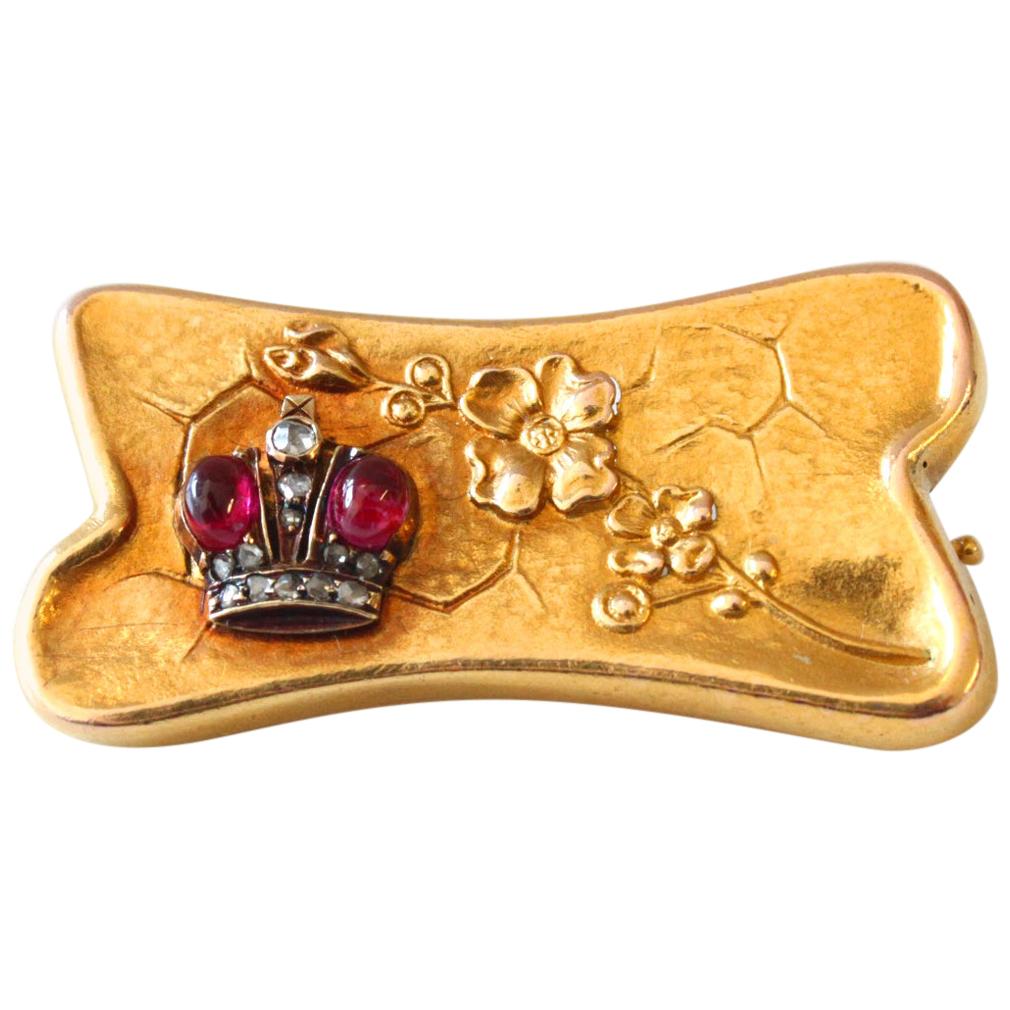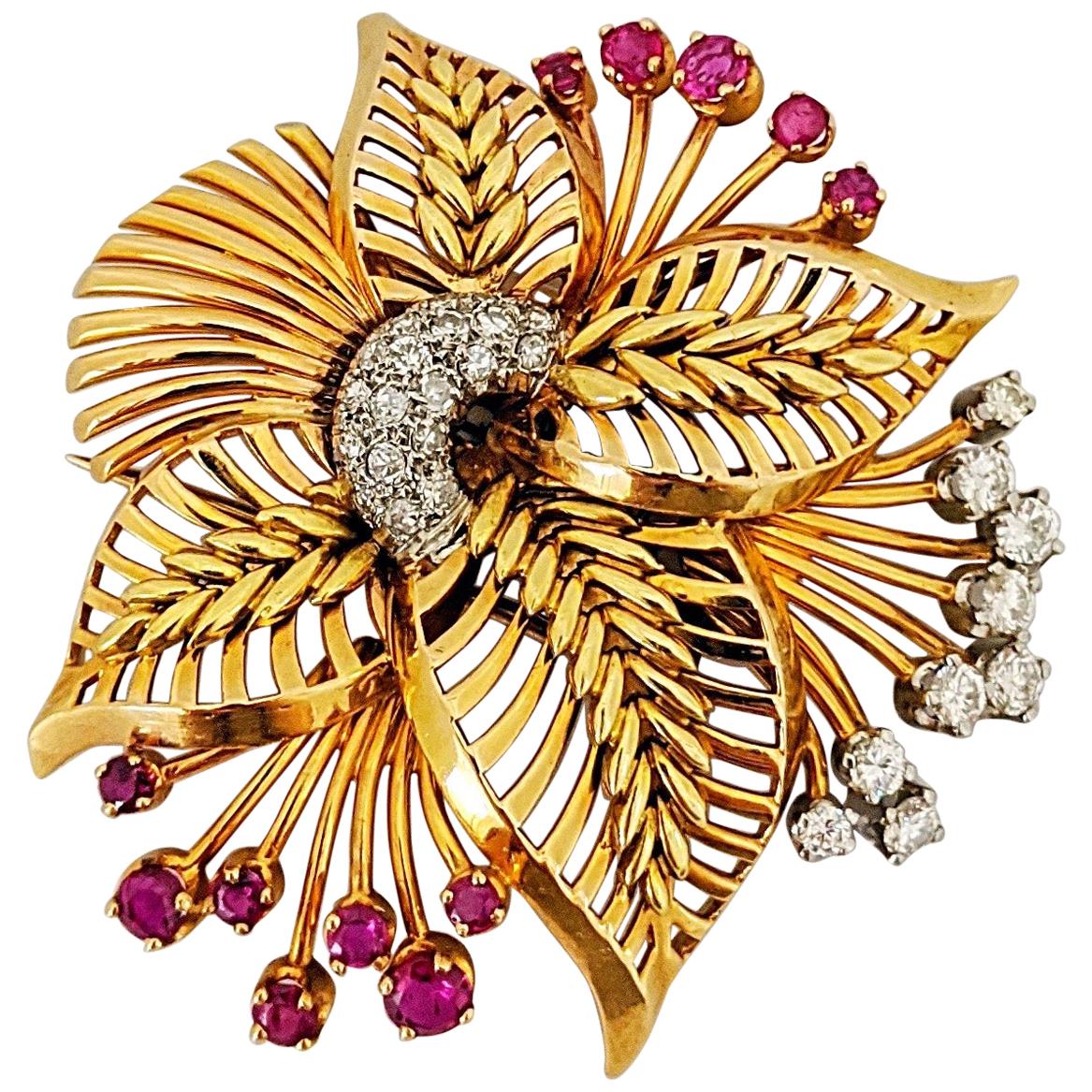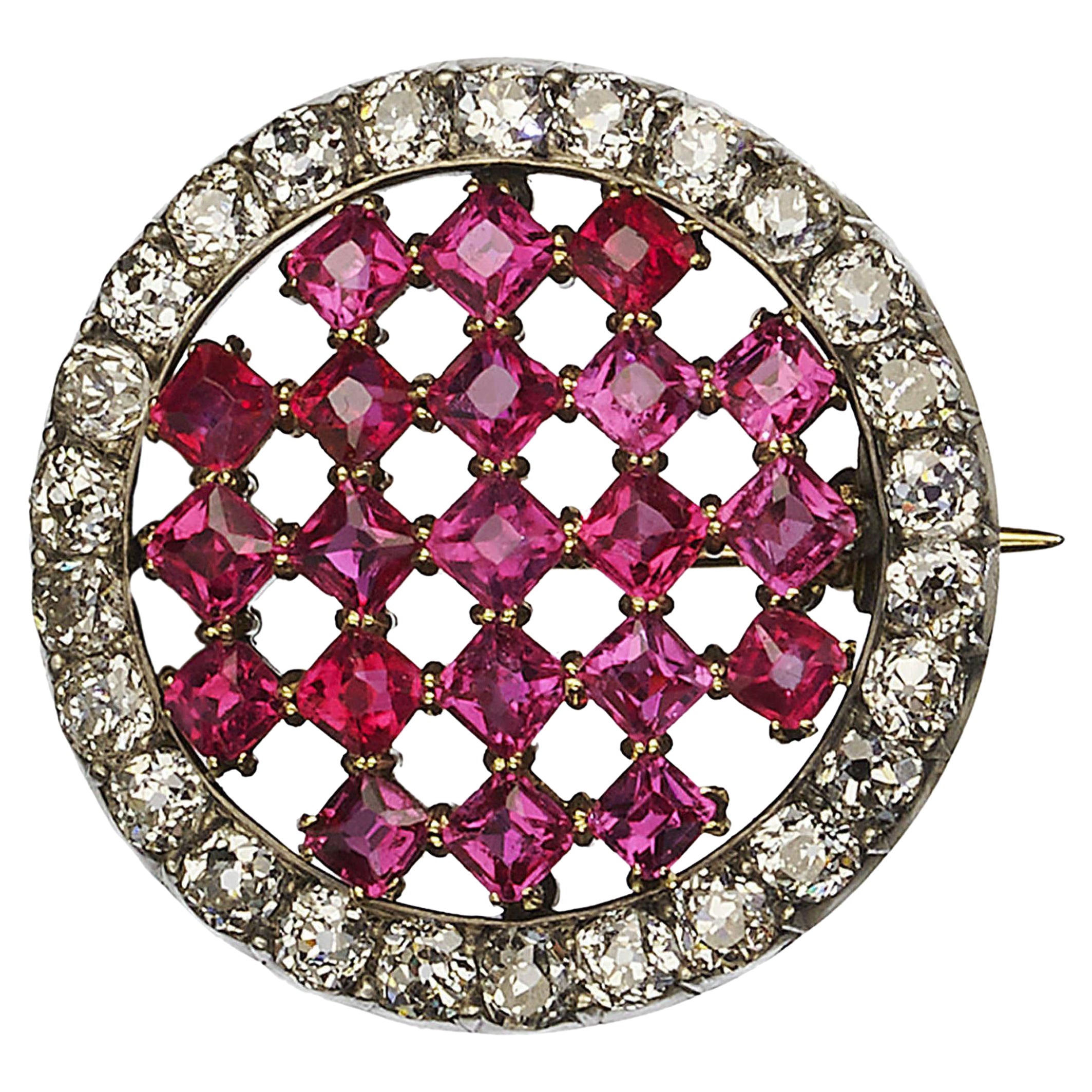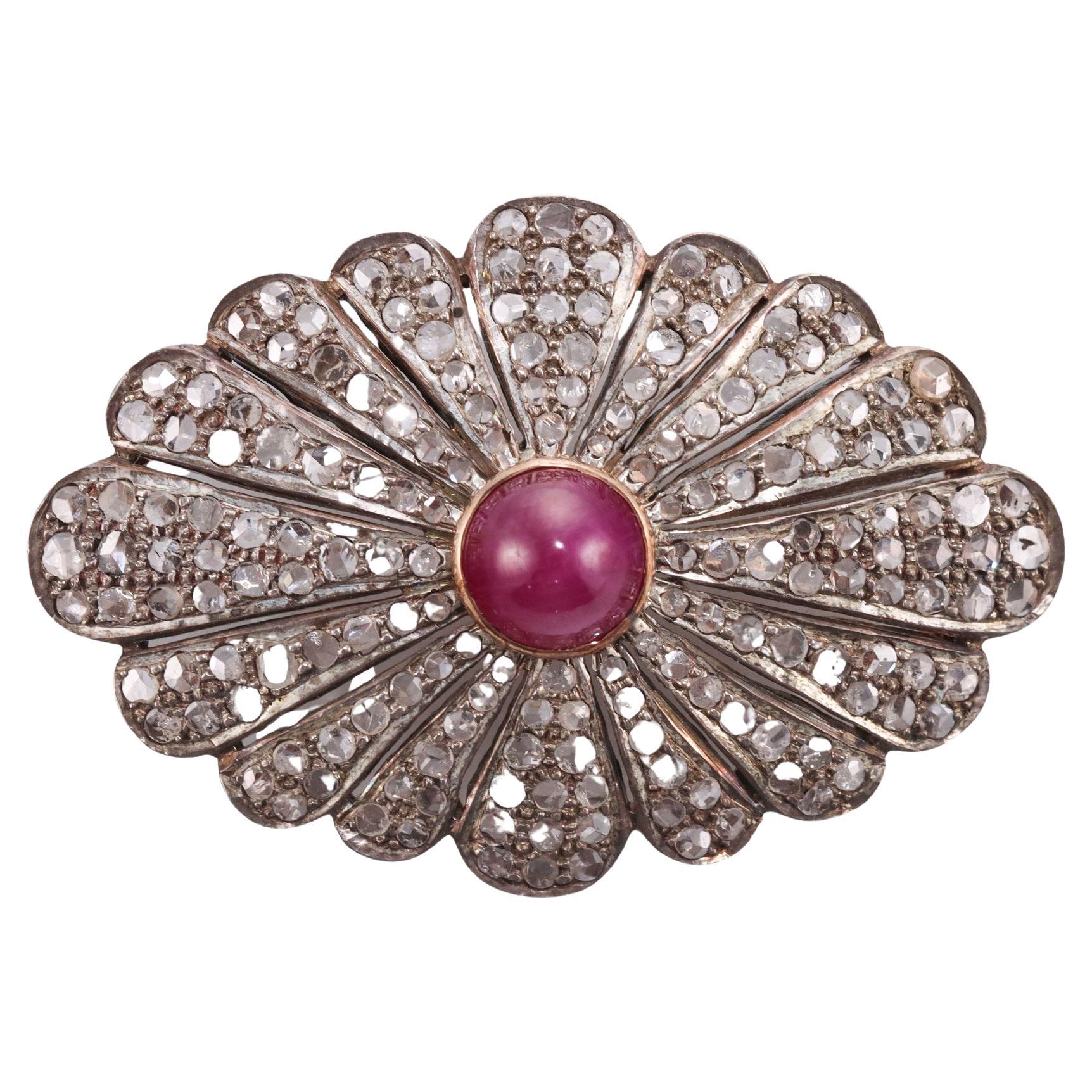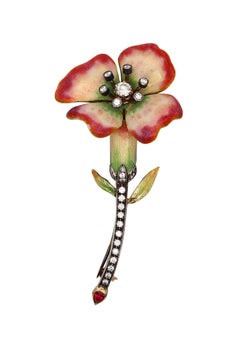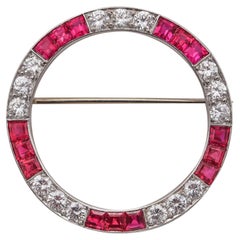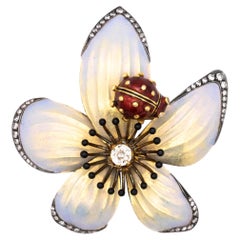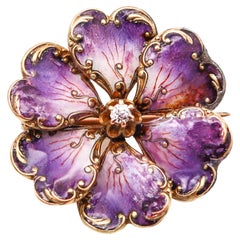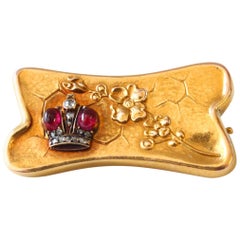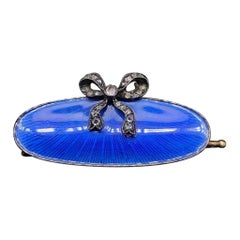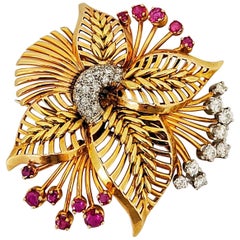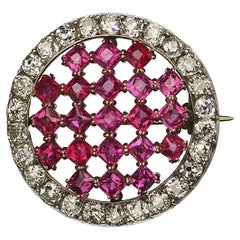Items Similar to FABERGE by Knut Oskar Pihl 1895 Enameled Pink Guilloche Brooch In Gold & Diamond
Want more images or videos?
Request additional images or videos from the seller
1 of 10
FABERGE by Knut Oskar Pihl 1895 Enameled Pink Guilloche Brooch In Gold & Diamond
$36,760
$45,95020% Off
£28,104.98
£35,131.2220% Off
€32,371.26
€40,464.0720% Off
CA$51,512.03
CA$64,390.0420% Off
A$57,508.34
A$71,885.4220% Off
CHF 30,133.50
CHF 37,666.8820% Off
MX$703,958.51
MX$879,948.1320% Off
NOK 382,695.81
NOK 478,369.7620% Off
SEK 360,833.56
SEK 451,041.9520% Off
DKK 241,590.01
DKK 301,987.5120% Off
About the Item
An enameled guilloche brooch designed by Knut Oskar Pihl / Oskar Pihl for Faberge.
This is a fabulous antique brooch created in Moscow Russia during the imperial period, circa 1895. This belle epoque brooch has been designed with neo-classic patterns in the Louis XVI style, at the workshop of Fabergé’s work-master in Moscow Knut Oskar Pihl senior (active 1887-1897) and retailed by Fabergé at the Moscow branch. The brooch was made up with several parts crafted in solid yellow gold of 14 karats with a delicate curvilinear silver frame. Mounted with a nice assortment of one-hundred-forty-four rose-cuts diamonds and embellished with an engine turned guilloche panel, which is topped with iridescent pink glass enamel. It is fitted at the reverse with a concealed hinged horizontal pin bar and a security safety hook.
Knut Oskar Pihl senior
Knut Oskar Pihl (1860-1897) became master in 1887 and marked in Latin letters OP in an oval cartouche. In his workshop was mainly made jewelry but also some small art objects. The production was exclusively sold in Faberge’s shop in Kuznetski most 4 in Moscow. It is stated that Knut Oskar Pihl was named Oscar Gustavovich Pill and marked in Cyrillic ОП. That is not the case. His name was Knut Oskar Pihl and he marked OP with Latin letters only. However, in Russia he might have used the patronymic name Gustavovitsh according to local habits. He father's name was Gustaf. Oskar married August Holmstrom's daughter Fanny Florentina (1869-1949) in 1887 and they had 5 children of which two of them became very famous goldsmiths. They were Alma Theresa Phil (1888-1976) who designed the famous Winter egg and Oskar Pihl (1890-1959) prominent Fabergé work master.
Oskar Pihl junior
Oskar Woldemar Pihl was a Russian silversmith of Finnish origin, a grandson of world-famous silver and goldsmith August Wilhelm Holmström and son of Knut Oskar Pihl. Both the grandfather and the grandson were prominent Fabergé work-masters. Following in his grandfather’s footsteps, Oskar learned the trade and became a jeweler, he made small items such as enameled tie pins and brooches. Although he had started his work in Saint-Petersburg, after the Russian Revolution in 1917 he moved to Finland, where he continued his journey as a craftsman. Later on, Oskar Pihl became a designer and an art director at Tillander, Finnish company, that manufactures jewelry, founded in Saint Petersburg and currently based in Turku, Finland. Exquisite pieces of jewelry art, his works were acknowledged all over the world. Oskar Pihl became the knight, first class of the Order of the White Rose of Finland and the knight of the Order of the Lion of Finland, two of the three official orders in Finland. What is remarkable, the design of that very Order of the Lion badge was created by no one, but Oskar Pihl himself. Distinguished pieces of art, created by Oskar Pihl both when working at Fabergé and afterwards are still considered as some of world’s finest jewelry items and treasured by collectors from all over the world.
Alma Theresa Pihl
She was destined to be one of Fabergé’s most unique designers, Alma was born in Moscow, daughter of Knut Oskar Pihl, the head of the Fabergé workshop in Moscow and the granddaughter of August Holmström, Fabergé’s leading jeweler. Following the death of her father in 1897, Alma’s mother moved the family into the St. Petersburg home of her parents. Here Alma studied drawing with Eugen Jakobson (1877-1940) an artist for the Fabergé firm. The pattern-drafting lessons he provided gave the gifted Alma the background that would eventually land her a job with her uncle Albert Holmström as a trainee in the Fabergé workshops. Her task was to document the items being produced in the workshop by rendering a life-size detailed drawing of the item, documenting the gemstones and other materials used, and noting the cost.
Country: Moscow, Imperial Russia.
Period: Edwardian, belle epoque 1895-1905.
Designer: Knut Oskar Pihl (works-master mark), Alma Pihl (daughter), Oskar Pihl (son).
Retailer: Faberge, Moscow or Saint Petersburg branches.
Diamonds: Mount in flush Mille-grain settings, with an assortment of 144 sparkling calibrated rose cut diamonds, with a total weight of about 0.74 carats, F/G/H color, SI clarity.
Weight: 10.2 Grams, (6.55 Dwt).
Measurements: 33 mm by 26 mm by 4 mm (1.30 x 1.02 x 0.16 Inches).
Hallmarks: Stamped with Imperial Russian marks, the pre-1899 mark of St. George in horse for the city of St. Petersburg, the maker's mark OP inside an oval cartouche associated to Knut Oskar Pihl / Oskar Pihl, the zolotnik standard mark for the assay and warranty of the .583/.999 gold, remains of unidentified numbers and signed as follows, "OP 56".
Zolotnik
The zolotnik was also used to measure fineness of precious metals (gold, silver, platinum). In this case, the ratio zolotnik/font was meant, so one zolotnik meant 1⁄96. For example, 14-karat (58.33%) gold was named "56-zolotnik gold" in Russia.
Guilloché
This term is used in fine jewelry to enhance the appearance of brooches, rings and pendants. Guilloché enamel refers to metal pieces that have been given the Guilloché treatment and then covered with a translucent layer of enamel, giving the geometric patterns underneath the enamel a colorful hue.
Millegrain
This is a jewelry technique which refers to the textural effect of a close-set line of metal beads that are typically used as a border on the edges or bezels of jewelry.
Literature: Tillander-Godenhielm, Ulla. Jewels from Imperial St. Petersburg, London: Unicorn Press Ltd. 2012. Weir-de La Rochefoucauld, Juliet. Women Jewellery Designers, Suffolk, UK: ACC Art Books, 2017.
Collateral: This Fabergé / Knut Oskar Pihl brooch is accompanied by a presentation jewelry box.
Collateral: This Fabergé / Knut Oskar Pihl brooch is accompanied by a certificate appraisal prepared by a GIA certified gemologist stating all the characteristics of this piece of jewelry, the exact description of the gemstones and the today's market replacement value.
Condition: The overall condition of this Fabergé / Knut Oskar Pihl brooch is excellent. Besides the little normal wear, there is no damage to the gold. The 144 diamonds and the enamel are secured in the settings. This brooch was carefully inspected to guarantee the condition and authenticity.
INVENTORY REF: P061225EENM/.1912
- Creator:Fabergé by Oskar Pihl
- Metal:Gold,Yellow Gold,Silver,Enamel,14k Gold
- Stone:Diamond,White Diamond
- Stone Cut:Rose Cut
- Weight:10.2 g
- Dimensions:Height: 1.02 in (25.91 mm)Depth: 0.18 in (4.58 mm)Length: 1.36 in (34.55 mm)
- Style:Belle Époque
- Place of Origin:Russia
- Period:1890-1899
- Date of Manufacture:1895
- Condition:Wear consistent with age and use. The overall condition of this Fabergé / Knut Oskar Pihl brooch is excellent. Besides the little normal wear, there is no damage to the gold. The 144 diamonds and the enamel are secured in the settings. This brooch was carefully inspected to guarantee.
- Seller Location:Miami, FL
- Reference Number:Seller: P061225EENM/.19121stDibs: LU2690226568212
About the Seller
5.0
Recognized Seller
These prestigious sellers are industry leaders and represent the highest echelon for item quality and design.
Platinum Seller
Premium sellers with a 4.7+ rating and 24-hour response times
Established in 1995
1stDibs seller since 2022
918 sales on 1stDibs
Typical response time: <1 hour
- ShippingRetrieving quote...Shipping from: Miami, FL
- Return Policy
Authenticity Guarantee
In the unlikely event there’s an issue with an item’s authenticity, contact us within 1 year for a full refund. DetailsMoney-Back Guarantee
If your item is not as described, is damaged in transit, or does not arrive, contact us within 7 days for a full refund. Details24-Hour Cancellation
You have a 24-hour grace period in which to reconsider your purchase, with no questions asked.Vetted Professional Sellers
Our world-class sellers must adhere to strict standards for service and quality, maintaining the integrity of our listings.Price-Match Guarantee
If you find that a seller listed the same item for a lower price elsewhere, we’ll match it.Trusted Global Delivery
Our best-in-class carrier network provides specialized shipping options worldwide, including custom delivery.More From This Seller
View AllART NOUVEAU 1915 Enameled Flower Brooch In 18Kt Gold With Diamonds & Ruby
Located in Miami, FL
Art Nouveau enameled flower brooch.
This fabulous three-dimensional flower brooch was created in Europe during the Art Nouveau periods, back in the 1915 The beautiful brooch has bee...
Category
Vintage 1910s German Art Nouveau Brooches
Materials
White Diamond, Ruby, Diamond, 18k Gold, Enamel, Yellow Gold, Gold
$7,160 Sale Price
20% Off
Free Shipping
Raymond Yard 1935 Art Deco Brooch In Platinum With 4.82 Ctw Rubies Diamonds
By Raymond C. Yard
Located in Miami, FL
An art deco brooch designed by Raymond C. Yard.
Fantastic circular brooch, created in America during the art deco period by the master jewelry designer Raymond C. Yard, back in the ...
Category
Vintage 1930s American Art Deco Brooches
Materials
Diamond, White Diamond, Ruby, Platinum
$11,988 Sale Price
20% Off
Free Shipping
Moira of London Rare Art Nouveau Enameled Brooch in 18Kt with 1.51 Ctw Diamonds
Located in Miami, FL
Exceptional brooch designed by Moira of London.
A very rare and important piece created by the famed jewelers Moira with Art-Nouveau patterns. Crafted...
Category
Vintage 1970s Art Nouveau Brooches
Materials
Diamond, White Diamond, Gold, 18k Gold, Yellow Gold, Enamel
$7,160 Sale Price
20% Off
Free Shipping
Art Nouveau 1905 Edwardian Enameled Purple Flower Brooch 14Kt Gold with Diamond
Located in Miami, FL
Edwardian enameled purple flower brooch.
Beautiful three-dimensional piece, created in America during the Edwardian and the Art Nouveau periods, ...
Category
Antique Early 1900s American Art Nouveau Brooches
Materials
Diamond, White Diamond, Gold, 14k Gold, Yellow Gold, Enamel
$1,438 Sale Price
20% Off
Free Shipping
Edwardian 1905 Art Nouveau Enamel Flower Pendant Brooch 14kt Gold with Diamonds
Located in Miami, FL
Edwardian enameled flower convertible brooch.
An extremely beautiful piece, created in America during the Edwardian and the Art Nouveau periods, back in the 1900-1910. This outstand...
Category
Antique Early 1900s American Edwardian Brooches
Materials
Pearl, White Diamond, Diamond, Enamel, Yellow Gold, 14k Gold, Gold
$2,788 Sale Price
20% Off
Free Shipping
Cartier Paris 1900 Edwardian Guilloche Enamel Pin 18Kt Gold Platinum And Diamond
By Cartier
Located in Miami, FL
Belle Epoque pin designed by Cartier.
Colorful and very rare stick pin made during the Edwardian-Belle Epoque period. This beautiful piece was created in Paris France by the jewelry house of Cartier, back in the 1900. Carefully crafted in two parts made up of solid platinum, yellow and white gold of 18 karats. Embellished with a central panel decorated with engine turned guilloche topped with purple glossy enamel. Accented with thirty-five natural earth mined rose cut diamonds and the settings are finished with millegrain.
Diamonds: Mounted in millegrain settings, with 35 old rose cut diamonds, 0.30 carats, G/H color, SI-1 clarity.
Weight: 2.35 Grams, (1.51 Dwt).
Measurements: 70 mm by 12 mm (2.76 x 0.47 Inches).
Hallmarks Stamped with French marks, the maker's maitre mark CA inside a lozange cartouche, the head of the eagle for the assay and warranty of the gold, the four digits serial numbers and signed, "CARTIER PARIS 3840".
Cartier
The move to the rue de la Paix coincided with a period of extraordinary economic growth and affluence in France and the world. Cartier was also growing and expanding and had started to shift their emphasis from retailing to design and manufacture. Although they produced a small number of pieces in the Art Nouveau style, Cartier paid scant attention to the movement. They made their distinguishing mark in pioneering the use of platinum in creating the delicate and graceful Garland style that came to be associated with the Belle Époque. The discovery of the great diamond deposits in South Africa in the late 1860’s engendered the popularity of extravagant diamond jewelry. The technical advances in the manufacturing of platinum enabled designs of great intricacy, strength and flexibility such as found in the spectacular résille designs of Cartier. (See Edwardian Jewelry: 1901-1915). Cartier marked the beginning of the twentieth century by opening branches in London and New York, where their wealthiest and most dedicated clientele resided. The 1902 coronation of Edward VII occasioned a large number of commissions from England’s leading families. Records indicate that Cartier produced twenty-seven tiaras alone for the coronation and the event was instrumental in convincing the firm to seek a permanent presence in London. Indeed, by 1904 they had achieved their first of fifteen royal warrants being appointed official purveyor to the court of King Edward VII. The London branch came to thrive under the tutelage of Alfred’s youngest son, Jacques Cartier, establishing London based design and manufacturing workshops. Opening a Cartier store in New York was a natural progression as many of America’s wealthiest families and business magnates had been traveling to Paris for some time to purchase their jewels from Cartier. By 1906 Alfred had largely retired and Louis and his brother Pierre operated the Cartier business jointly. One of their first major decisions was to establish a New York presence and workshop in 1909 under the skilled direction of Pierre. Indicative of his business skills, Pierre famously secured Cartier’s present location, an elegant Beaux-Arts mansion at 653 Fifth Avenue, from industrialist Morton F. Plant in 1917. The building changed hands in exchange for $100 and a double strand of natural pearls, admired by Plant’s wife and valued at one million dollars, the asking price for the mansion. While the Fifth Avenue location remains priceless to the firm, when the pearls came up for auction in 1957, they fetched a mere $170,000. (From Lang's with thanks).
Edwardian Jewelry
This Period was during the King Edward VII, after whom this period of jewelry history is named, reigned over England for only nine years, yet the style of jewelry known as “Edwardian” was created roughly between 1890 and 1920. Edwardian-era rings tend to be larger, opulent pieces, and stacked ring designs were popular. The metal surfaces of the rings were often diamond-encrusted for additional shimmer. Each of these rings is a work of art, showcasing a bygone era of grace, elegance and the royalty the Edwardian era is named for.
Guilloché
This term is used in fine jewelry or objects de Vertu to enhance the appearance of boxes, frames, brooches, rings or pendants. Guilloché enamel refers to metal pieces that have been given the Guilloché treatment and then covered with a translucent layer of enamel, giving the geometric patterns underneath the enamel a colorful hue.
Millegrain
This is a jewelry technique which refers to the textural effect of a close-set line of metal beads that are typically used as a border on the edges or bezels of jewelry.
Literature: Sotheby's fine jewels, London September 17 1021, Lot 146 for an identical piece illustrated with the original box
Collateral: It is accompanied by the original Cartier presentation green jewelry box...
Category
Antique Early 1900s French Edwardian Drop Necklaces
Materials
White Diamond, Diamond, Enamel, Platinum, Yellow Gold, White Gold, 18k G...
$5,598 Sale Price / set
20% Off
Free Shipping
You May Also Like
Fabergé Ruby Diamond Presentation Brooch, circa 1890s
By Peter Carl Fabergé
Located in Idar-Oberstein, DE
Fabergé Ruby and Diamond Presentation Brooch, ca. 1890s
A rare brooch depicting a blooming cherry blossom twig on a honeycomb background and showing an imperial crown with rubies and diamonds.
This brooch is by the workmaster August Hollming (1854-1913), ca. 1880s, who worked for Fabergé. Peter Carl...
Category
Antique Late 19th Century Russian Russian Empire Brooches
Materials
Diamond, Ruby, 14k Gold
Fabergé Enamel and Diamond Brooch Circa 1900
By Karl Fabergé
Located in London, GB
A Fabergé enamel and diamond brooch, circa 1900.
A rare, hand crafted 14ct yellow gold and silver brooch by Karl Fabergé, comprised of a roy...
Category
Antique Early 1900s Russian Russian Empire Brooches
Materials
Diamond, Yellow Gold, Silver, Enamel, 14k Gold
18 Karat Rose Gold Brooch with Diamonds and Rubies, circa 1940s
Located in New York, NY
Retro brooch circa 1940's . Classically designed with round brilliant Diamonds and Rubies set in 18 karat rose gold.
12 Rubies approximately 1.02 carats
9 Brilliant cut Diamonds appr...
Category
Vintage 1940s Unknown Retro Brooches
Materials
Diamond, Ruby, 18k Gold, Rose Gold
Antique Austrian Burma Ruby, Diamond and Silver-Upon-Gold Brooch, Circa 1890
Located in London, GB
An antique, Austrian, Burma ruby and diamond chequerboard brooch, with French-cut rubies, in claw settings, surrounded by old-cut diamonds, in silver cut down settings, mounted in go...
Category
Antique 1890s Austrian Belle Époque Brooches
Materials
Ruby, Diamond, Silver, Gold
Fabergé Ruby and Diamond Set Brooch in Yellow Gold
By Fabergé
Located in London, GB
A late nineteenth century Fabergé ruby and diamond set brooch in yellow gold, the open marquise-shaped gold jewel set with a curved row of rubies and anot...
Category
Antique 1890s Russian Russian Empire Brooches
Materials
Diamond, Ruby, Yellow Gold
Antique Silver Gold Rose Cut Diamond Ruby Brooch
Located in New York, NY
Antique 14k gold and silver brooch, featuring rose cut diamonds and center 8mm ruby cabochon. Brooch measures 46mm x 30mm. Tested gold and silver,...
Category
Antique 19th Century Brooches
Materials
Diamond, Ruby, Gold, Silver
More Ways To Browse
Antique Jewelry Stamps
Gold Cartouche
Antique Jewelry Company
Faberge 1890
Antique Jewellery Boxes London
Women Antique Jewelry
Translucent Enamel Jewelry
Faberge Gold Box
Russian Jewellery Box
999 Gold Jewelry
Faberge Glasses
Guilloche And Faberge
Faberge Frame
Guilloche Enamel Frames
Engine Turned Gold
Pink Enamel Box
Antique Faberge
Russian Gold Silver Jewelry
